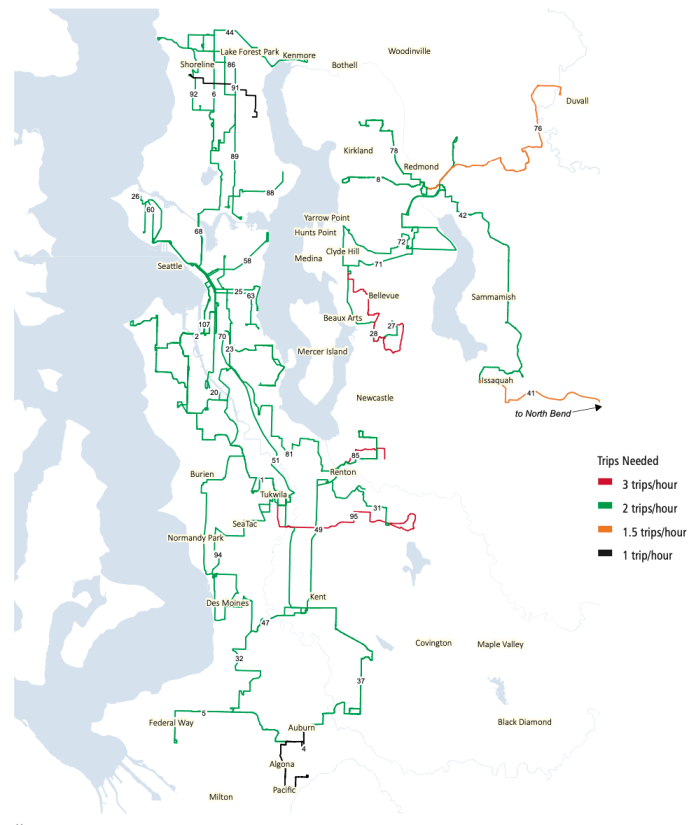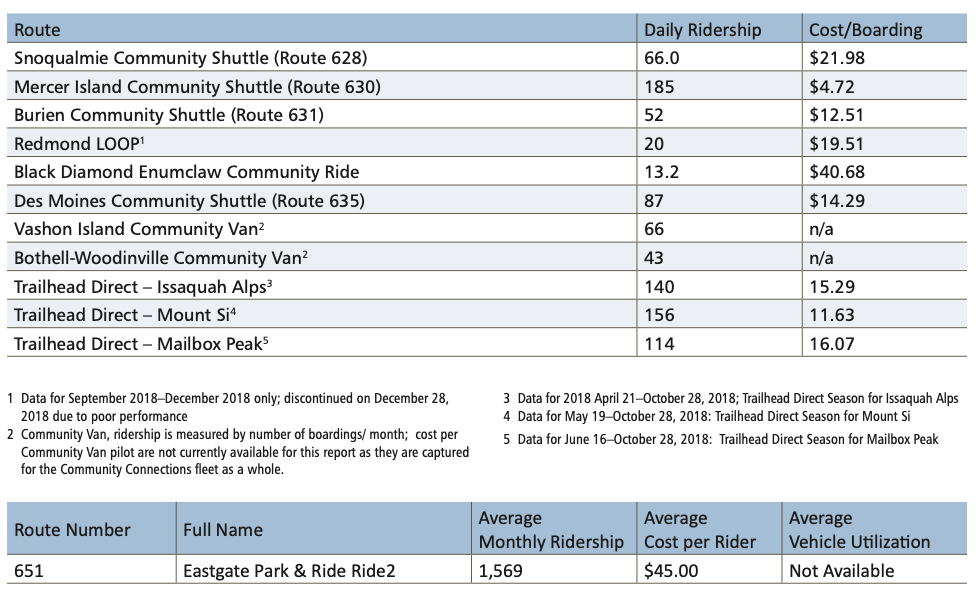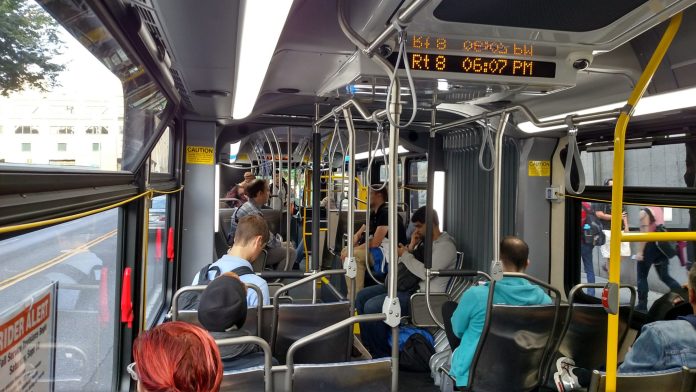The annual system evaluation for King County Metro from 2019 shows that 455,510 annual service hours are needed to meet baseline service targets. To realize the larger Metro Connects long-range plan, approximately two million additional annual service hours would be needed to roll out more frequent and complete service across King County.
King County Metro currently operates 4.2 million service hours per year and has made some headway in the past year to increase service levels. From the fall of 2018 through the spring of 2019, Metro added 40,900 annual service hours in line with its service guidelines and another 46,700 annual service hours in Seattle from Seattle Transportation Benefit District funding. A further 68,900 service hours were programmed for addition as part of the fall service change in 2019.
Metro’s service guidelines use a tiered priority approach to determine where investments should go. There are three key priorities highlighted in the system evaluation:
- Priority 1: investments that reduce crowding on buses;
- Priority 2: investments that improve reliability of service; and
- Priority 3: investments that can grow ridership.
To inform where priority investments should go, the system evaluation includes extensive route-level productivity and performance data analysis.
Based upon that analysis, Metro indicates that Priority 3 has the largest backlog in investment need. The system evaluation showed that an additional 420,100 annual service hours are needed to grow service. That is down from the year prior when it estimated 452,600 annual service hours were needed to fulfill this priority. Priority 2 was the second highest area of investment need at 25,450 annual service hours to address reliability issues; this is about two-thirds the need from 2018. Lastly, about 9,600 additional annual service hours are needed to reduce crowding issues, largely at peak hours. Crowding is up from 2018 when only 7,800 new annual service hours were needed to address that priority by Metro’s count.
Priority 1 Overcrowding Investments
Metro has identified 19 bus routes that are chronically overcrowded. This is defined as either a vehicle having an average maximum load exceeding its capacity or an average passenger load that is more than number of seats for 20 consecutive minutes. This is determined by trends over several months, not just individual occurrences.
The number of bus routes on the overcrowding list has grown by one since last year. Some of last year’s overcrowding issues, however, were resolved allowing seven bus routes to drop off the list , but 10 of the 19 bus routes are new to it. Three of those new routes on the list meet the first overcrowding criteria while the remainder meet the second criteria.
Metro has indicated that most of these overcrowding issues are experienced during peak-hour periods, which is probably little surprise. However, the transit agency’s capacity issues due to lack of equipment and storage of vehicles at bus buses makes overcrowding a challenge to address. Short of other means operational improvements–like bus lanes, camera enforcement, and transit signal priority–to free up buses for more trips, this will continue to be a problematic priority–at least until bus base expansions come online.
Generally speaking, the overcrowding list is North Seattle and North King County heavy with 10 routes. Of these, the RapidRide D Line needs the most investment with three daily trips. Routes 63 and 77 both need two additional daily trips to reduce peak-hour issues. Other routes on the list include Routes 5X, 13, 14, 15X, 17X, 18X, 33, 40, 41, 114, 120, 123, 268, 271, and 312 and the RapidRide E Line.

Priority 2 Reliability Investments
Reliability continues to be a struggle for Metro. The need for investment jumped by 6,200 annual service hours even though some headway was made last year through implementation of all-door boarding, off-board payment on Third Avenue, stop consolidation, and new service hours. About half the bus routes–for a total of 32–were removed from the list. However, severe congestion and new surface pathways has kept the number of routes on the list high at 63, which is a net increase of two routes over the 2018.
Some of the new routes on the list only require small investments to pad their runtimes. That includes the likes of Routes 153 and 197 that have been impacted by I-5 congestion and Routes 181, 232, and 241 that are being affected by local conditions. Interestingly though, Metro also has noted that weekend reliability has been struggling Saturdays alone needing an extra 7,950 annual service hours to deal with congestion. Metro’s analysis indicates that the most investment needed for reliability includes Routes 40, 5, 106, 8, 48, 62, 21, 107, and 131.

Priority 3 Ridership Growth Investments
In terms of ridership growth, Metro has a list of 53 corridors that need additional service hours. This could be seen as improvement somewhat over last year since that is one fewer route on the list and annual service hour needs have fallen by 32,500. Metro successfully added tens of thousands of hours in the past year to address ridership growth needs, but transit ridership has also been flatlining over the past year due to a variety of factors, putting less pressure on service growth.
During the peak-hour periods, Metro has indenitifed 40 corridors that could benefit from additional service to facilitate ridership growth. These corridors are largely concentrated in Redmond, Seattle, Shoreline, Renton, Bellevue, and Tukwila. Off-peak midday periods have a more moderate number of corridors in need of investment totaling 29. New service for those periods are most needed in Seattle, Redmond, Bellevue, Renton, and Federal Way. Evening and late-night service needs are limited to just 16 corridors. These are primarily in North Seattle, Shoreline and nearby communities, Redmond, Renton, and Bellevue.
Routes that Need Peak-time Investment

Routes that Need Midday Investment

Routes that Need Nighttime Investment

Other Mobility Investments
The system evaluation also analyzed alternative mobility tools that Metro has been pursing in recent years, such as Community Shuttles, Community Vans, Trailhead Direct, and Ride2. On the bright side of this, the Community Shuttles for Snoqualmie (Route 628) and Mercer Island (Route 630) saw ridership increases of 8.4 and 11.4 daily riders respectively with manageable cost increases per boarding. Trailhead Direct, which links urban riders to rural trails, data was still preliminary for the report, but indications are that ridership has been growing and has community support.

However, other highlighted mobility services appear to be struggling for Metro. The Burien Community Shuttle (Route 631) saw daily ridership fall by 27.3 and Ride2, an app-based microtransit service, closed up shop in Eastgate due to poor performance during the evaluation period. The West Seattle Ride2 service also ended in December. However, a similar service called Via to Transit has been expanded in parts of Seattle and still operates in Tukwila and Sea-Tac. Community Ride in Black Diamond and Enumclaw maintained abysmal ridership in 2019 at extraordinary costs and the Redmond LOOP was cancelled early in the reporting period at the end of 2018.
Service Guidelines Changes Ahead
Looking ahead, Metro is planning to revise its service guidelines and strategic plan to align with the Metro Connects long-range vision. Meaningful progress on this is expected to happen this year and could involve adoption of the revisions. Specific changes to the guidelines could include the parameters and strategy of partnerships with smaller cities, adjusting how service investments are prioritized by incorporating other considerations of the system (e.g., passenger facilities, equipment and storage, and speed and reliability improvements), and how Metro carries out pilot programs and works with third parties to deploy them.
Stephen is a professional urban planner in Puget Sound with a passion for sustainable, livable, and diverse cities. He is especially interested in how policies, regulations, and programs can promote positive outcomes for communities. With stints in great cities like Bellingham and Cork, Stephen currently lives in Seattle. He primarily covers land use and transportation issues and has been with The Urbanist since 2014.


